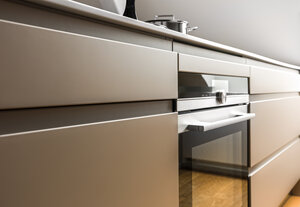Basic cleaning
Basic cleaning is usually performed by routine application of hot aqueous cleaning solutions. Suitable cleaning substances are conventional cleaning agents and also universal fat-dissolving cleaning agents. Let thicker or dry dirt soften first. Afterwards, the damp surface is wiped with hot clean water until all detergent residues are removed. It is then wiped dry with a piece of cloth that leaves no thread, preferably "in the direction of the decor" or evenly in one direction, not to cause smudges. Never use detergents, wipes, or sponges that contain abrasive scrubbing parts. These include liquid abrasive cleaners, polishes, and sponges (e.g., Scotch Britt and others). Scrubbing and scrubbing cleaners can irreversibly damage the delicate surface of the material. "Balm" cleaners are also not suitable for cleaning. The skin-safe substances in these compositions form a coating on the melanin resin surface, which is very difficult to remove. Alcohol-based cleaners (e.g., glass cleaners) or plastic cleaners are also not recommended. The surface should only be exposed to contact with aggressive cleaning agents or descalers, if they must be used, for a very short time. Any drops must be cleaned immediately. Prolonged exposure to these cleaning agents can cause microcracks or embrittlement of the surface, resulting in stains or "maps" that cannot be removed. In our experience, the surfaces will remain completely clean if these instructions are followed.
Thorough cleaning
If residues remain on the surface after this cleaning, it is recommended to proceed with intensive cleaning of the affected areas, while the relevant instructions for use must be observed. For this intensive cleaning, common grease-dissolving cleaners should be used, suitable for plastic surfaces, e.g., Sidol or Mellerud kitchen cleaners (available in drugstores, building material shops). The cleaning method must comply with the manufacturer's instructions on the packaging: it is usually a matter of applying the cleaning agent, letting it react, and the subsequent basic cleaning according to the above instructions. Before the first use, it is recommended to test the product on a hidden part of the object. In the case of long-term impurities due to their layering or in the case of poorly soluble sediments, the procedure must be repeated several times.
Special cleaning
To remove particular contaminants such as limescale, paraffin, candle residues, silicone, paints, varnishes, and adhesives, we recommend following the instructions in the technical sheet "Cleaning of HPL surfaces," which can be found at www.pro-HPL.org. We do not accept any liability for damage caused by the user.


